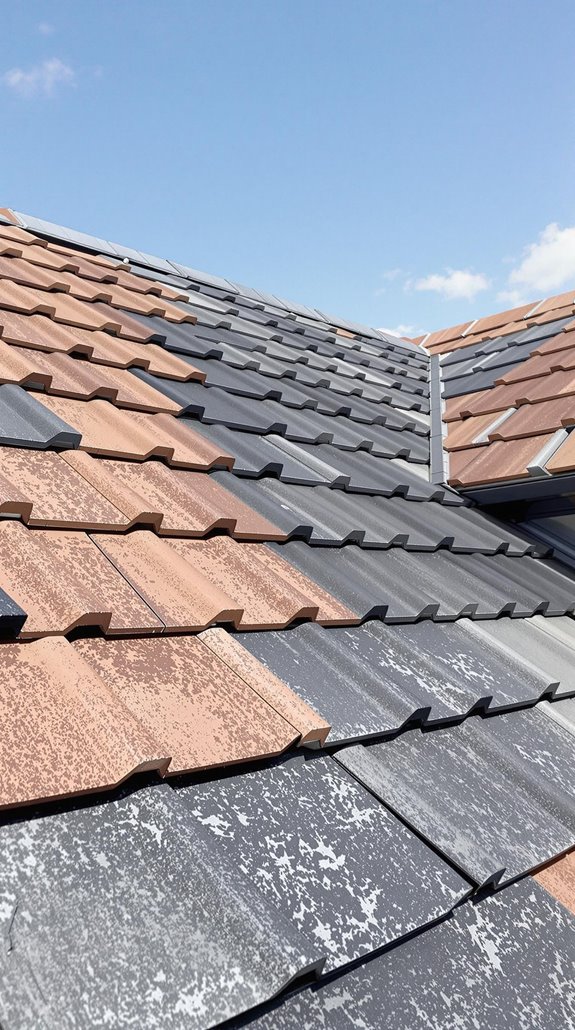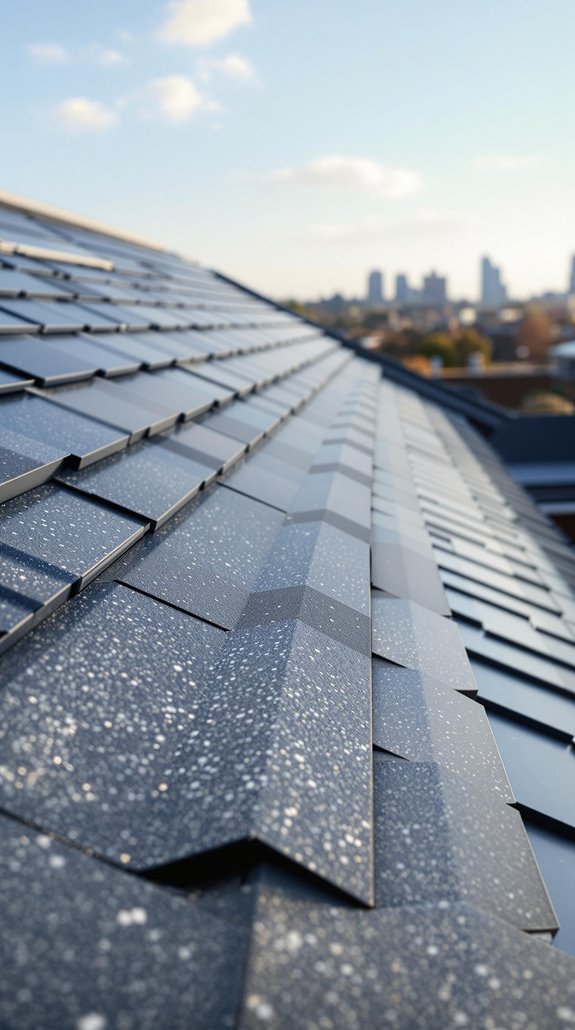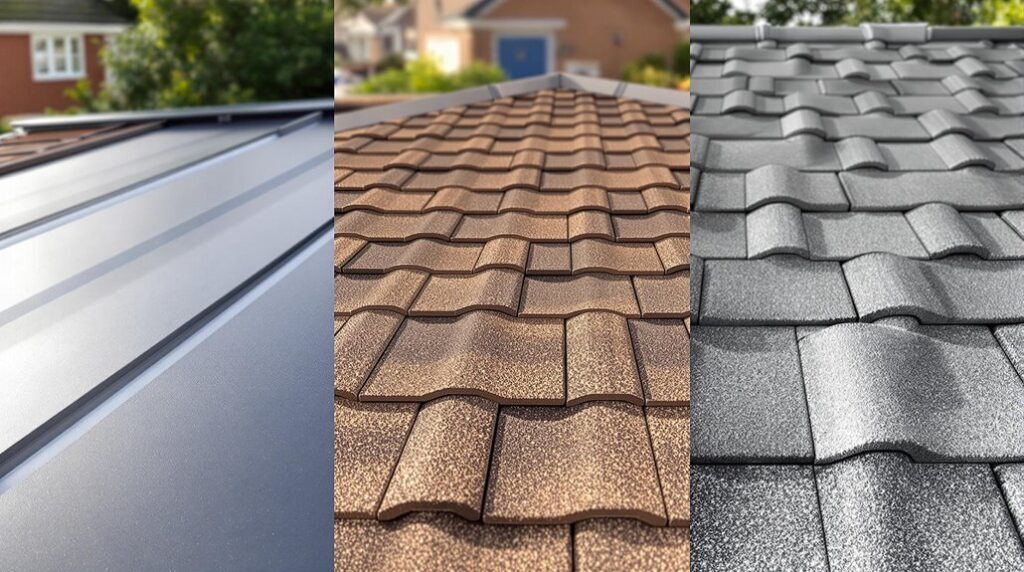I’ve spent years evaluating roofing materials across the UK, and I can tell you that today’s options go far beyond traditional slate and clay tiles. What’s changed isn’t just the materials themselves—it’s how they’re engineered to handle our unpredictable weather while cutting long-term costs. From synthetic polymers that outlast natural alternatives to smart coatings that predict maintenance needs, there’s a science behind choosing the right system for your specific situation.
Key Takeaways
- Concrete tiles dominate UK roofing with 66.1% projected market share by 2025, offering exceptional durability and affordability.
- Natural slate provides over 100 years of service life, while quality clay tiles last 50-100 years with proper maintenance.
- Synthetic polymer roofing captures 15% of the domestic market, delivering 50-year durability with 25% faster installation speeds.
- Modern metal roofing systems withstand 0.6 kN/m² loads and increase installation speed by 30% compared to traditional tiles.
- High-performance PVC and TPO membranes offer superior chemical resistance and UV reflectivity for enhanced energy efficiency.
Traditional Clay and Slate Roofing for Long-Term Performance

While modern synthetic materials dominate today’s roofing market, traditional clay and slate materials continue to define the UK’s architectural landscape, appearing on approximately 30% of homes nationwide.
I’ll tell you why these materials remain relevant: they’re built for the long haul. Natural slate delivers over 100 years of service with proper maintenance, while quality clay tiles offer 50-100 year lifespans. You’re investing in materials that withstand our harsh weather when properly installed by skilled craftspeople. Regular inspections can help identify potential issues that may arise over time, ensuring the longevity of your roof.
Clay tiles now cost considerably less than slate, making them economically attractive while replicating traditional aesthetics. Scotland’s historic slate quarries—over 80 operated in the 19th century—created our roofing heritage. Today, you’ll find clay tiles offer the best balance of authenticity, durability, and affordability for long-term performance. Together, clay and concrete tiles provide versatile and cost-effective solutions that cover 60% of homes across the UK.
Synthetic Polymer Solutions for Cost-Effective Durability
As traditional materials face increasing cost pressures, synthetic polymer roofing solutions have emerged as the UK’s fastest-growing roofing segment, capturing over 15% of the domestic market through their combination of affordability and performance.
I’ve found these materials particularly compelling for their environmental credentials. Products like Envirotile use recycled polymer construction, creating lightweight tiles that install 25% faster than traditional slates. Their interlocking design works on pitches as low as 12.5 degrees, while costing less per square meter than leading brands.
Single-ply membranes offer another practical approach. PVC systems provide 50-year durability with chemical resistance, while EPDM delivers UV protection lasting 20-40 years. These membranes feature self-extinguishing properties that enhance building safety standards. Whether you’re tackling extensions or full roofing projects, these synthetic options deliver professional results without breaking budgets.
Metal Roofing Systems for Wind Resistance and Energy Efficiency

Metal roofing systems have transformed from basic agricultural coverings into sophisticated building solutions that excel in Britain’s challenging weather conditions. I’ve observed how modern double skin systems—featuring liner, spacer, insulation, and outer sheet—dominate UK installations due to their superior performance. These systems are particularly essential for homeowners planning home extensions as they provide durability and aesthetic appeal.
You’ll find these systems engineered to withstand 0.6 kN/m² general loads and 0.9 kN point loads, with manufacturers providing load span tables ensuring wind resistance compliance. Secret fix profiles and trapezoidal designs enhance uplift resistance considerably.
What’s particularly impressive is their energy efficiency. Built-up systems let you control insulation thickness, while composite panels offer all-in-one solutions with mineral wool or PIR cores. Installation speed increases by 30% compared to traditional tiles, and systems like R-MER TILE ST include 20+20 year guarantees, proving their long-term value. These advanced systems feature zip-free seams that enhance installation efficiency and provide superior weather protection.
Concrete Tiles as Affordable Alternatives to Natural Materials
Beyond the high-tech appeal of metal systems, concrete tiles represent the UK’s most practical roofing solution, capturing a projected 66.1% market share by 2025. I’ve seen how these tiles deliver exceptional value, offering significant affordability compared to natural slate or premium clay while maintaining superior longevity.
You’ll find concrete tiles excel in our challenging weather conditions, resisting heavy rain, wind, and UV exposure with minimal degradation over decades. The pre-treated surfaces inhibit mold and stains, reducing your maintenance burden considerably. Their exceptional weather resistance makes them particularly suitable for hurricane-prone regions, where impact-resistant concrete tiles have seen a 22% year-over-year demand increase. Additionally, choosing strategic extensions that complement your roofing materials can further enhance your property’s value.
What I appreciate most is their design flexibility—diverse styles, textures, and colors match any architectural aesthetic. Recent innovations like triple-interlocking designs streamline installation, cutting labor costs while delivering the natural material appearance you want at budget-friendly prices.
Smart Technology Integration for Predictive Maintenance

While concrete tiles dominate through cost-effectiveness, smart technology integration transforms how we maintain UK roofs through predictive analytics and real-time monitoring. I’ve observed how IoT sensors embedded within roofing structures continuously track temperature, moisture levels, and structural integrity, delivering instant data that surpasses traditional inspection methods.
These systems reduce emergency repairs by 25% through early issue identification. AI-driven algorithms analyze sensor data to forecast maintenance needs months in advance, cutting long-term costs by 30%. Remote diagnostics eliminate physical inspections, reducing labor costs by 40%.
Drone-assisted inspections revolutionize assessments, covering large commercial roofs in hours rather than days while cutting costs by 50%. Dedicated moisture sensors extend roof lifespan by 50%, preventing structural decay through precise leak detection and targeted repairs. Thermographic imaging detects hidden moisture or insulation deficiencies through temperature variations, providing comprehensive assessments that complement traditional inspection methods.
Advanced Protective Coatings and Weather-Resistant Membranes
Although traditional coatings provide basic protection, graphene-enhanced protective coatings revolutionize UK roofing through impenetrable barriers that combine silicone and polyurethane properties. I’ve seen these advanced systems block oxygen and water penetration while creating superior rust and corrosion resistance. You’ll find they’re eco-friendly alternatives that extend metal roof lifespan considerably.
Liquid-applied roofing systems offer seamless membrane solutions that eliminate vulnerable joints. I recommend these cold-applied, low-odour formulations for occupied buildings where you need effective leak repairs without disruption. These systems provide odour-free application that’s particularly suitable for sensitive environments like food factories and industrial settings where air quality is critical.
High-performance membranes like PVC and TPO provide chemical resistance and UV reflectivity, though they’re vulnerable to punctures and seam failures. For commercial, educational, and emergency service buildings, I suggest customized protective solutions that address sector-specific challenges while delivering reduced lifecycle costs.
Conclusion
I’ve covered the key modern roofing materials available in the UK, each offering distinct advantages for your property. Whether you’re prioritizing cost-effectiveness with concrete tiles, seeking lightweight durability through synthetic polymers, or requiring maximum wind resistance with metal systems, there’s a solution that’ll meet your specific needs. Don’t overlook smart technology integration and advanced protective coatings – they’ll greatly extend your roof’s lifespan while reducing long-term maintenance costs and improving overall performance.
References
- https://www.acuteroofing.co.uk/the-top-roofing-materials-for-uk-homes-in-2025
- https://haddenhamroofingrepairs.co.uk/6-durable-roofing-materials-that-withstand-the-uk-climate/
- https://roof-troopers.com/blog/modern-roofing-materials/
- https://www.giromax.co.uk/blog/5-commercial-roofing-industry-trends-innovations-in-2025/
- https://www.lowcarbonbuildings.org.uk/energy/03/2025/7-roofing-materials-that-can-improve-energy-efficiency/9401/
- https://jgreedyroofingcardiff.co.uk/roofing-in-the-uk-key-statistics-and-trends/
- https://www.engineshed.scot/building-advice/building-materials/slate/
- https://www.spab.org.uk/sites/default/files/SPAB Technical Advice Note_Slate and Stone Roofing in Wales and the Marches_0.pdf
- http://www.slateroof.co.uk/Slates_v._Tiles.html
- https://www.wienerberger.co.uk/tips-and-advice/roofing/clay-vs-slate-tiles.html

